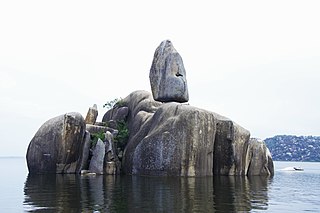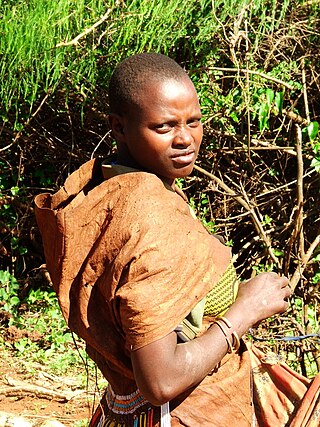
The Maasai are a Nilotic ethnic group inhabiting northern, central and southern Kenya and northern Tanzania, near the African Great Lakes region. The Maasai speak the Maa language, a member of the Nilotic language family that is related to the Dinka, Kalenjin and Nuer languages. Except for some elders living in rural areas, most Maasai people speak the official languages of Kenya and Tanzania, being Swahili and English.

The Serengeti National Park is a large national park in northern Tanzania that stretches over 14,763 km2 (5,700 sq mi). It is located in eastern Mara Region and northeastern Simiyu Region and contains over 1,500,000 hectares of virgin savanna. The park was established in 1940.
Sungusungu are Tanzanian justice organizations established originally by the Sukuma and Nyamwezi ethnic groups in 1981 to protect cattle from theft and other property. These organizations operate at the community level and enforce a variety of different rules. The group was deputized by the Tanzanian government in 1989. In some regions "they ended up being more influential than the Tanzanian Police Force." Human rights groups have criticized the organizations for being vigilantes who have murdered people without trials. In neighboring Kenya, the name Sungusungu describes a particular vigilante organization which has been banned since 2007.

Mwanza City, also known as Rock City to the residents, is a port city and capital of Mwanza Region on the southern shore of Lake Victoria in north-western Tanzania. With an urban population of 1,311,000 in 2023, it is Tanzania's second largest city, after Dar es Salaam. It is also the second largest city in the Lake Victoria basin after Kampala, Uganda and ahead of Kisumu, Kenya at least in population size. Within the East African community, Mwanza city is the fifth largest city after Dar, Nairobi, Mombasa, and Kampala. It is slightly ahead of Kigali, Kisumu, and Bujumbura in the population of city proper limits. Mwanza city is also the capital city of Mwanza Region, and is administratively divided into two municipal districts within that Region - Ilemela and Nyamagana.

The Nyamwezi, or Wanyamwezi, are one of the Bantu groups of East Africa. They are the second-largest ethnic group in Tanzania. The Nyamwezi people's ancestral homeland is in parts of Tabora Region, Singida Region, Shinyanga Region and Katavi Region. The term Nyamwezi is of Swahili origin, and translates as "people of the moon" or "people of the west", the latter being more meaningful to the context.

Kwimba District is one of the seven districts of the Mwanza Region of Tanzania. It is bordered to the north by the Magu District, to the east by Maswa District and Kishapu District, to the south by Shinyanga Rural District, and to the west by Misungwi District. The district seat is at Ngudu. Sumve is another important settlement in Kwimba District, hosting a hospital and large church.

Mwanza Region is one of Tanzania's 31 administrative regions. The region covers a land area of 25,233 km2 (9,743 sq mi). The region is comparable in size to the combined land area of the nation state of North Macedonia. Mwanza Region is bordered to the north through Lake Victoria by the Kagera Region and Mara Region, to the east by Simiyu Region, to the south by the Shinyanga Region and to the west by Geita Region. The regional capital is the city of Mwanza. According to the 2022 national census, the region had a population of 3,699,872 and national census of 2012 had 2,772,509. Mwanza Region is the second region with high population in Tanzania after Dar es Salaam Region.

Shinyanga Region is one of Tanzania's 31 administrative regions. The region covers a land area of 18,555 km2 (7,164 sq mi). The region is comparable in size to the combined land area of the nation state of Fiji. The region is bordered to the north by the Mwanza, Mara, and Kagera Regions and to the south by the Tabora Region. In addition, the Kigoma Region borders the region to the west, and the Simiyu Region and a sliver of Singida Region to the east. The regional capital is the municipality of Shinyanga. According to the 2022 national census, the region had a population of 2,241,299.

Tabora Region is one of Tanzania's 31 administrative regions. The regional capital is the municipality of Tabora. The region is located in mid-western part of Tanzania. Tabora is bordered by Shinyanga to the north, Singida to the east, Mbeya and Songwe to the south. lastly, Katavi, Kigoma and Geita, border Tabora to the west. Tabora is by far the largest region in Tanzania by area. Most of the population in the region is concentrated in the north in Nzega district. According to the 2022 national census, Tabora Region had a population of 3,391,679.
The Gogo also known as Gongwe(Wagogo, in Swahili) are a Bantu ethnic and linguistic group based in the Dodoma Region of central Tanzania. In 1992 the Gogo population was estimated to number 1,300,000..

Maswa District is one of the five districts of the Simiyu Region of Tanzania Inhabited by Sukuma. It is bordered to the north by Magu District and Itilima District, to the east by the Meatu District, to the south by the Kishapu District, and to the west by the Kwimba District. Its administrative centre is the town of Maswa.
Unyamwezi is a historical region in what is now Tanzania, around the modern city of Tabora to the south of Lake Victoria and east of Lake Tanganyika. It lay on the trade route from the coast to Lake Tanganyika and to the kingdoms to the west of Lake Victoria. The various peoples of the region were known as long-distance traders, providing porters for caravans and arranging caravans in their own right. At first the main trade was in ivory, but later slaving became more important.

The Turu are an ethnic and linguistic group based in the Singida Region of north-central Tanzania who speak Bantu language Kinyaturu. In 1993, the Turu population was estimated to number 556,000. The current population of the Turu is now over 1,000,000. They speak the Turu language.

The Barabaig(Wabarabaig, in Swahili) are a nomadic tribe of the Datooga people based in the northern volcanic highlands near Mount Hanang in Manyara Region, Tanzania, speaking the eponymous dialect of the Datooga language. Their population is about 50,000.
Datooga is a Nilotic language or dialect cluster of the Southern Nilotic group. It is spoken by the Datooga people of the Great Rift Valley of Tanzania. The Sukuma name Taturu is also sometimes used in English; the Swahili name Mang'ati comes from Maasai, where it means "enemy". However, it is not considered offensive to the Datooga, as there is a degree of pride in being the historic enemy of the Maasai, and Mang'ati has become the standard name for the group in Swahili. In addition, numerous tribal and dialectal names may be found for the people or language as a whole.

Geita Region is one of Tanzania's 31 administrative regions. The region covers an area of 20,054 km2 (7,743 sq mi)."Geita Region Size". The region is comparable in size to the combined land area of the nation state of Slovenia. Geita Region is bordered to the east by Lake Victoria, Mwanza Region and Shinyanga Region. The region is bordered by Tabora Region and Kigoma Region to the south and south west respectively. Lastly, Gieta is borders Kagera Region to the west.

Simiyu Region is one of Tanzania's 31 administrative regions. The region covers a land area of 25,212 km2 (9,734 sq mi). The region is comparable in size to the combined land area of the nation state of North Macedonia. The region is bordered to the north by the Mara Region, to the south by the Shinyanga Region and Singida Region. Mwanza Region borders the region to the west through Lake Victoria, and Arusha Region to the east. The region is home to the Serengeti National Park, a UNESCO World Heritage Site, shared with Mara Region. The regional capital is the town of Bariadi. According to the 2022 national census, the region had a population of 2,140,497.

Busega District is one of the five districts of Simiyu Region of Tanzania, East Africa. Its administrative centre is the town of Nyashimo. It is bordered to the north by Lake Victoria and Bunda District, to the east by Bariadi District, and to the south by Magu District.
Hans CoryOBE was a self-taught British social anthropologist of Austrian descent, farmer and sociologist with a special interest in traditional lifestyles of ethnic groups in former Tanganyika, now Tanzania. Little is known about his childhood and youth in Vienna as well as about his life before the First World War in colonial German East Africa.
Saigilo was a Datooga King and medicine man reputed for his purported skill in thaumaturgy and divination, which has led to his establishment as a folk figure within Iraqw and Datooga society in present-day Karatu District in Arusha Region, northern Tanzania.

















